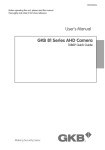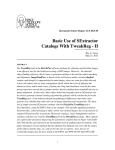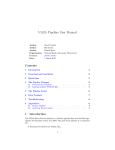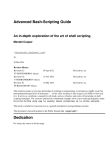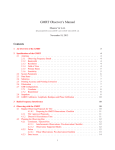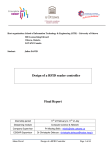Download VLBA Pipeline: Outline of Data Reduction Heuristics 1 Introduction
Transcript
VLBA Pipeline: Outline of Data Reduction Heuristics Gareth Hunt, Bill Cotton, & Jared Crossley September 28, 2012 1 Introduction The VLBA Pipeline was designed to take uncalibrated VLBA visibility data directly from the NRAO archive and to create a file set for reingestion into the archive or for direct use by end users. This file set contains reference images with associated diagnostic plots, reports, scripts, and log files, plus calibrated visibility data with associated tables. The scripts can be used to set non-default values to processing parameters and used to repeat part or all of the processing if the default processing is inadequate. 1.1 Scope The scope of the present version of the pipeline is: • VLBA data only It may work with the inclusion of other telescopes if all of the VLBA calibration tables are available. • 1-15 GHz The pipeline has been used on continuum data sets with frequencies as high as 43 GHz with robust results. • Calibrated fluxes Calibration uses standard external calibration and does not include coherence losses. • Continuum imaging Spectral line data sets can have the continuum calibration done but no spectral cubes are made. Corrections based on the pulsed–cal system may need to be turned off if this system was not used. • Imaging including self-calibration Multi–resolution imaging with self calibration is done. • No polarization No polarization calibration/imaging is currently implemented. 1 1.2 Software The VLBA pipeline is: • Written in python, and • Uses Obit and AIPS tasks to do the data processing, and • Uses AIPS data structures for intermediate data, and • Writes FITS images and (AIPS FITAB format) calibrated datasets. The pipeline scripts are publically available for checkout from a Subversion (SVN) repository (https://svn.cv.nrao.edu/svn/VLBApipeline). AIPS (http://www.aips.nrao.edu/index.shtml) and Obit (http://www.cv.nrao.edu/ bcotton/Obit.html) are installed on all NRAO Linux computers and available for installation via download to non-NRAO computers. 1.3 Prototype Comparison The Mojave project was selected as an initial set of observations. This comprises more than 150 datasets, each roughly 24 hours in duration, observing sources to track morphological changes over time. The observations are snapshots mostly at 2cm (Ku-band) with some 3cm (X-band) observations. This extended project has the advantage that the data have already been calibrated and imaged by experts, and that the resultant images are publicly available for direct comparison with the images produced by the pipeline. The FITS images of the Mojave project are available at http://www.nrao.edu/2cmsurvey/. For consistency between epochs, the Mojave project necessarily has limitations on the data that they fully reduce. The VLBA pipeline has no such limitations, and about 3500 individual images were produced from data taken between August 2003 and December 2011. These images typically had dynamic ranges (peak:rms) of 25-35dB. Roughly 3200 images were available for direct comparison. The comparison was excellent. On average, the integrated fluxes for the pipeline were just over 5% lower than the images in the Mojave catalog, as predicted. 2 2 The Process The pipeline processing uses the following processes. Many of the default processing parameters are frequency dependent and may be overridden and the various steps may be turned on or off. The following gives an overview of the processing. Details are documented in the main pipeline processing script, VLBAContPipe.py, and in the routines called in VLBACals.py (see python online documentation). The processing is driven by a parameter script which is initially automatically generated but may be modified for detailed control of the processing; parameters are described in the Appendix. These are described in more detail in the VLBA Pipeline User Manual. 1. Data retrieved from the archive Pre-DifX data may be either multiple FITS IDI format files or a single AIPS UVFITS data file. Data from the DifX correlator are in a single FITS IDI format file. 2. Data converted to AIPS format Multiple FITS IDI format files can be concatenated. 3. “Flag” Data at low elevations and at low fringe rates are flagged using AIPS/UVFLG. 4. Initial data filtering The data are edited with a running median window (Obit/MednFlag) to flag deviant data such as when an antenna is late on source. 5. Standard “external” calibration (a) 1/2 bit sampling correction Uses AIPS task ACCOR. (b) Parallactic angle correction Phases are corrected for the effects of parallactic angle. Uses AIPS task CLCOR. (c) Ionospheric correction (TEC) Relevant ionospheric models are downloaded from the Web and applied using AIPS/TECOR to correct for the Total Electron Content (TEC) given by the model. (d) Earth Orientation Parameters (EOP) The most recent IERS earth orientation parameters (UT1-UTC, 3 (e) (f) (g) (h) position of pole) are downloaded from the Web and used by AIPS/CLCOR to correct the VLBA correlator model with the “final” values. Tsys/atmosphere/gain correction The amplitudes are converted to Jy using measured system temperatures, standard gain curves and atmospheric opacity corrections estimated from the system temperatures. Uses AIPS task APCAL. These gains are smoothed before application to the data. Calibrator selection “Calibrator” sources are then determined by doing a fringe fit on all sources to determine which ones reliably give solid detections. The reference antenna is picked on the basis of strong source detections. The best calibration scan is then selected on the basis of the fringe fit signal–to–noise estimates. This scan is the one involving the largest number of antennas and with the highest average SNR. Obit task Calib is used for the fringe fitting. Pulse calibration The pulse cal signals are used to align the phases and delays of the various parts of the electronics. Since these are based on phase measurements from discrete tones, the delays are ambiguous. This ambiguity is resolved using fringe fit results for the “best” calibrator scan. Obit tasks PCCor + CLCal are used for this. “Manual” phase calibration There are generally residuals delay and phase errors after correction by the pulse calibration; these are corrected using delays and phases determined for the “best” calibrator scan and applied to all data. Obit tasks Calib + CLCal are used for this 6. Calibration from visibility data. (a) Initial calibrator self–calibration All sources deemed to be calibrators are self calibrated to provide initial images for further calibration. Phase calibration is applied and amplitude as well if the peak in the image exceeds a frequency dependent minimum value. Imaging uses Obit task SCMap. (b) Delay calibration Group delay fits are made using a fringe fit on the calibrator sources using the source models derived in the previous step. Obit tasks Calib + CLCal are used for the fringe fitting + correction. 4 (c) Bandpass correction A bandpass correction for the amplitudes and phases in each channel is determined from the best calibrator scan and the model derived for that calibrator from the cross–correlation data. No spectral index correction is included. Uses Obit task BPass. (d) Calibrator phase calibration Phase corrections on a short time scale are determined for the calibrator sources using the source models for each. This phase correction is then applied to the data (needed in the next step). Obit tasks Calib + CLCal are used. (e) Calibrator amplitude calibration Longer time amplitude solutions are determined for the calibrator sources. In able to prevent poor weather or other conditions at a small number of antennas from skewing the amplitude scale, a subset of the antennas with the most stable set of fitted gains are used to stabilize the flux density scale. The average gain for these antennas is divided into all gain solutions. The strong enough calibrator sources have the solutions determined for them applied in the calibration table. Other sources use a smoothed version of the amplitude calibration solutions. (f) Calibrate and average data. Calibration is applied and the data are averaged in frequency and possibly time. Subsequent steps use the averaged data. Uses Obit task Splat. (g) Self calibration of all sources An initial self calibration to get models of all sources is performed. Phase self–cal is always used and also amplitude self–cal if the peak in the image is above a given threshold. Imaging uses Obit task SCMap. (h) Data clipping Data with amplitudes significantly in excess of the sum of the CLEAN components for each source are flagged. (i) Phase calibration of all sources The source models are used to determine the phase corrections for all sources and these are applied to the cumulative calibration table. Obit tasks Calib + CLCal are used. 7. Imaging and production of results. 5 (a) Imaging Each source for which previous calibration was successful is then imaged. This final imaging may use phase and possibly amplitude self–calibration and the imaging uses multiple resolutions(2) to help recover extended emission. Obit task Imager is used for the imaging. (b) Saving images Final and calibration images are written to FITS files. (c) Saving visibility data The averaged and calibrated uv data and the tables from the initial data are written to AIPS FITAB format FITS files. (d) Reports Statistics of the images are determined and an HTML page constructed to simplify viewing the results. An XML file manifest is generated for re-ingestion into the archive. (e) Cleanup All AIPS data files are deleted. 3 The Products • Calibrated (u,v) dataset with calibration and flagging tables in AIPS FITAB format – Tables from initial data and averaged visibilities per input dataset. • FITS Images – one per source observed plus calibration images. • Diagnostic plots – several per image. • Reports and logs created during the process • Meta-data for a VOTable to describe the products The file set comprising all files and the meta-data are stored in a single directory. For approved pipeline use, this directory is stored on the lustre file system in NRAO Socorro. From there it is ingested directly into the NRAO archive. Sources that did not image acceptably are added to the failTargets list. This is referenced in the HTML Report. 6 A General Parameters This section lists the default global parameters used in the VLBA Pipeline scripts. They are only explained briefly, but experienced users should have no difficulty recognizing their use and functionality. It is clearly possible to re-run or re-start the pipeline using different values than the defaults. Several parameters are actually placeholders for derived intermediate products: failTarg, contCalModel, targetModel; although, in principle, contCalModel could be user-supplied. These are initialized as specified here at the beginning of the pipeline process but may be overridden in the parameter script. Quantization correction doQuantCor True QuantSmo 0.5 QuantFlag 0.0 Do quantization correction Smoothing time (hr) for quantization corrections If >0, flag solutions < QuantFlag (use 0.9 for 1 bit, 0.8 for 2 bit) Parallactic angle correction doPACor True Make parallactic angle correction Total Electron Content (TEC) correction doTECor True Make TEC correction Earth Orientation Parameters (EOP) correction doEOPCor True Make EOP correction Opacity/Tsys correction doOpacCor True Make Opacity/Tsys/gain correction? 0.25 Smoothing time (hr) for opacity corrections OpacSmoo Apply phase cal corrections? doPCcor True Apply PC table? doPCPlot True Plot results? “Manual” phase cal - even to tweak up PCals True Determine and apply manual phase cals? doManPCal manPCsolInt None Manual phase cal solution interval (min) manPCSmoo None Manual phase cal smoothing time (hr) doManPCalPlot True Plot the phase and delays from manual phase cal Special editing list doEditList False Edit using editList? editFG 2 Table to apply edit list to editList [] EditList 7 Do median flagging doMedn True mednSigma 10.0 mednTimeWind 1.0 mednAvgTime 10.0/60. mednAvgFreq 0 mednChAvg 1 Flag Suspect data doFlags True elLim 10.0 flag0 2.0 Editing doClearTab True doGain True doFlag True doBP True doCopyFG True doQuack False quackBegDrop 0.1 quackEndDrop 0.0 quackReason “Quack” Bandpass Calibration? doBPCal True 1 bpBChan1 bpEChan1 0 bpDoCenter1 None bpBChan2 bpEChan2 bpChWid2 bpdoAuto bpsolMode bpsolint1 bpsolint2 specIndex doSpecPlot 1 0 1 False ‘A&P’ None 10.0 0.0 True Median editing? Median sigma clipping level Median window width in min for median flagging Median Averaging time in min Median 1=>avg chAvg chans, 2=>avg all chan, 3=> avg chan and IFs Median number of channels to average UVFLG editing? Min. allowed source elevation (deg) if > 1. flag data near zero fringe rate Clear cal/edit tables Clear SN and CL tables >1 Clear FG tables > 1 Clear BP tables? Copy FG 1 to FG 2quack Quack data? Time to drop from start of each scan in min Time to drop from end of each scan in min Reason string Determine Bandpass calibration Low freq. channel,initial cal Highest freq channel, initial cal, 0=>all Fraction ofchannels in 1st, overrides bpBChan1, bpEChan1 Low freq. channel for BP cal Highest freq channel for BP cal,0=>all Number of channels in running mean BP soln Use autocorrelations rather than cross? Band pass type ‘A&P’, ‘P’, ‘P!A’ BPass phase correction solution in min BPass bandpass solution in min Spectral index of BP Cal Plot the amp. and phase across the spectrum 8 Amp/phase calibration parameters refAnt 0 Reference antenna refAnts [0] List of Reference antenna for fringe fitting Imaging calibrators (contCals) and targets doImgCal True Image calibrators targets [] List of target sources failTarg [] List of failed target (source,process) doImgTarget True Image targets? “ICalSC” Output calibrator image class outCclass outTclass “IImgSC” Output target temporary image class outIclass “IClean” Output target final image class Robust 0.0 Weighting robust parameter Niter 500 Max number of clean iterations minFlux 0.0 Minimum CLEAN flux density minSNR 4.0 Minimum Allowed SNR solMode “DELA” Delay solution for phase self cal avgPol True Average poln in self cal? avgIF False Average IF in self cal? maxPSCLoop 6 Max. number of phase self cal loops minFluxPSC 0.05 Min flux density peak for phase self cal maxASCLoop 1 Max. number of Amp+phase self cal loops minFluxASC 0.2 Min flux density peak for amp+phase self cal nTaper 1 Number of additional imaging multiresolution tapers Tapers [20.0,0.0] List of tapers in pixels False Make ref. pixel tangent to celest. sphere for each facet do3D noNeg False F=Allow negative components in self cal model Find good calibration data doFindCal True Search for good calibration/reference antenna findSolInt None Solution interval (min) for Calib findTimeInt None Maximum timerange, large=>scan contCals None Name or list of continuum cals contCalModel None No cal model targetModel None No target model yet If need to search for calibrators doFindOK True Search for OK cals if contCals not given minOKFract 0.5 Minimum fraction of acceptable solutions minOKSNR 20.0 Minimum test SNR failTarg [] list of failed sources 9 Delay calibration doDelayCal True delaySmoo None Amplitude calibration doAmpCal True Determine/apply delays from contCals Delay smoothing time (hr) Determine/smooth/apply amplitudes from contCals Stablize gains with best antennas? Fraction of antenna to use in stabilization List of antennas to exclude from stabilization List of antennas to always include in stabilization doStable True stableFract 0.667 [] stableBadAnts stableGoodAnts” [] Apply calibration and average? doCalAvg True calibrate and average cont. calibrator data avgClass “UVAvg” AIPS class of calibrated/averaged uv data CalAvgTime None Time for averaging calibrated uv data (min) CABIF 1 First IF to copy CAEIF 0 Highest IF to copy CABChan 1 First Channel to copy CAEChan 0 Highest Channel to copy chAvg 10000000 Average all channels avgFreq 1 Average all channels Phase calibration of all targets in averaged calibrated data doPhaseCal True Phase calibrate contCals data with self-cal? doPhaseCal2 True Phase target data with self-cal? Instrumental polarization cal? False determination instrumental polarization doInstPol from instPolCal instPolCal None Defaults to contCals Right-Left phase (EVPA) calibration doRLCal False Set RL phases from RLCal - also needs RLCal RLCal None RL Calibrator source name, if given, a list of triplets, (name, R-L phase (deg@1GHz), RM (rad/m2 )) 10 Clip excessive visibilities doClipFlag True Clip (flag) visibilities above sum of CCs? clipFactor 1.25 Factor above sum of CCs to clip clipTime 0.25 Time in min for which the data is to be averaged before clipping Final Image/Clean doImgFullTarget True Final Image/Clean/selfcal Stokes “I” Stokes to image True Contour plots doKntrPlots Final outDisk 0 FITS disk number for output (0=cwd) doSaveUV True Save uv data doSaveImg True Save images doSaveTab True Save Tables doCleanup True Destroy AIPS files copyDestDir ‘’ Destination directory for copying output files empty string -> do not copy Diagnostics doSNPlot True Plot SN tables etc doDiagPlots True Plot single source diagnostics prtLv 2 Amount of task print diagnostics doMetadata True Save source and project metadata doHTML True Output HTML report B Band-dependent Parameters This section lists the default band-dependent parameters used in the VLBA Pipeline scripts. They are only explained briefly, but experienced users should have no difficulty recognizing their use and functionality. It is clearly possible to re-run or re-start the pipeline using different values than the defaults. Note that the VLBA has two receiver bands below 1GHz (90cm and 50cm). The band-dependent parameters are the same for both bands. Note also that 9mm (Ka) is included for completeness in the software, but there is no receiver. 11 Parameter manPCsolInt manPCSmoo delaySmoo bpsolint1 FOV solPInt solAInt findSolInt findTimeInt CalAvgTime Description Manual phase cal solution interval (min) Manual phase cal smoothing time (hr) Delay smoothing time (hr) BPass phase correction solution in min Field of view radius in deg. phase self cal solution interval (min) amp+phase self cal solution interval (min) Solution interval (min) for Calib Maximum timerange, large=>scan Time for averaging calibrated uv data (min) Parameter manPCsolInt manPCSmoo delaySmoo bpsolint1 FOV solPInt solAInt findSolInt findTimeInt CalAvgTime <1GHz (P) 0.25 10.0 0.5 10/60 0.4/3600 0.10 3.0 0.1 10.0 10/60 Parameter manPCsolInt manPCSmoo delaySmoo bpsolint1 FOV solPInt solAInt findSolInt findTimeInt CalAvgTime 2cm (Ku) 0.5 10.0 0.5 10/60 0.05/3600 0.25 3.0 0.5 10.0 10/60 20cm (L) 0.5 10.0 0.5 15/60 0.4/3600 0.25 3.0 0.25 10.0 10/60 1cm (K) 0.2 10.0 0.5 10/60 0.05/3600 0.25 3.0 0.3 10.0 5/60 12 13cm (S) 0.5 10.0 0.5 10/60 0.2/3600 0.25 3.0 0.25 10.0 10/60 9mm (Ka) 0.2 10.0 0.5 10/60 0.04/3600 0.25 3.0 0.2 10.0 5/60 6cm (C) 0.5 10.0 0.5 10/60 0.2/3600 0.25 3.0 0.5 10.0 10/60 7mm (Q) 0.1 10.0 0.5 5/60 0.04/3600 0.1 3.0 0.1 10.0 5/60 3cm (X) 0.5 10.0 0.5 10/60 0.1/3600 0.25 3.0 0.5 10.0 10/60 3mm (W) 0.1 10.0 0.5 5/60 0.02/3600 0.1 3.0 0.1 10.0 4/60













